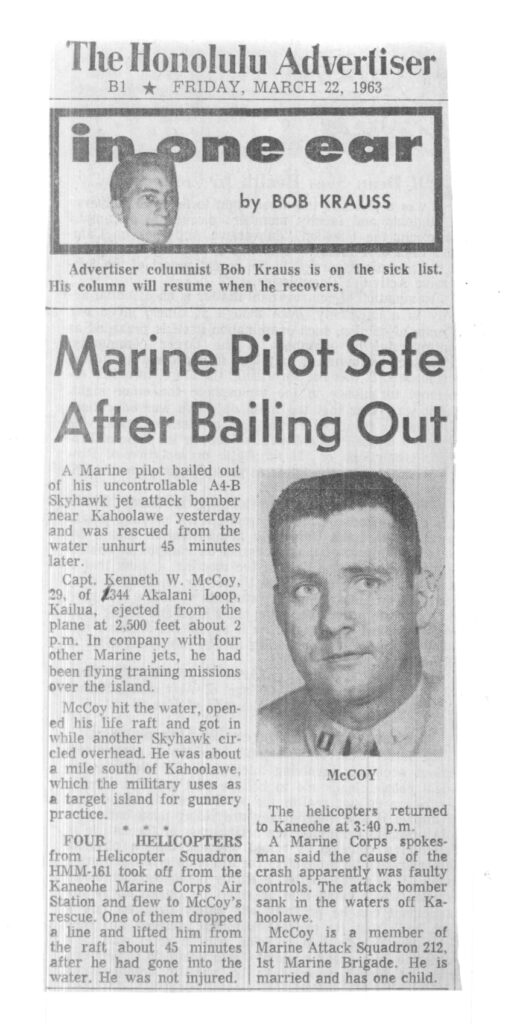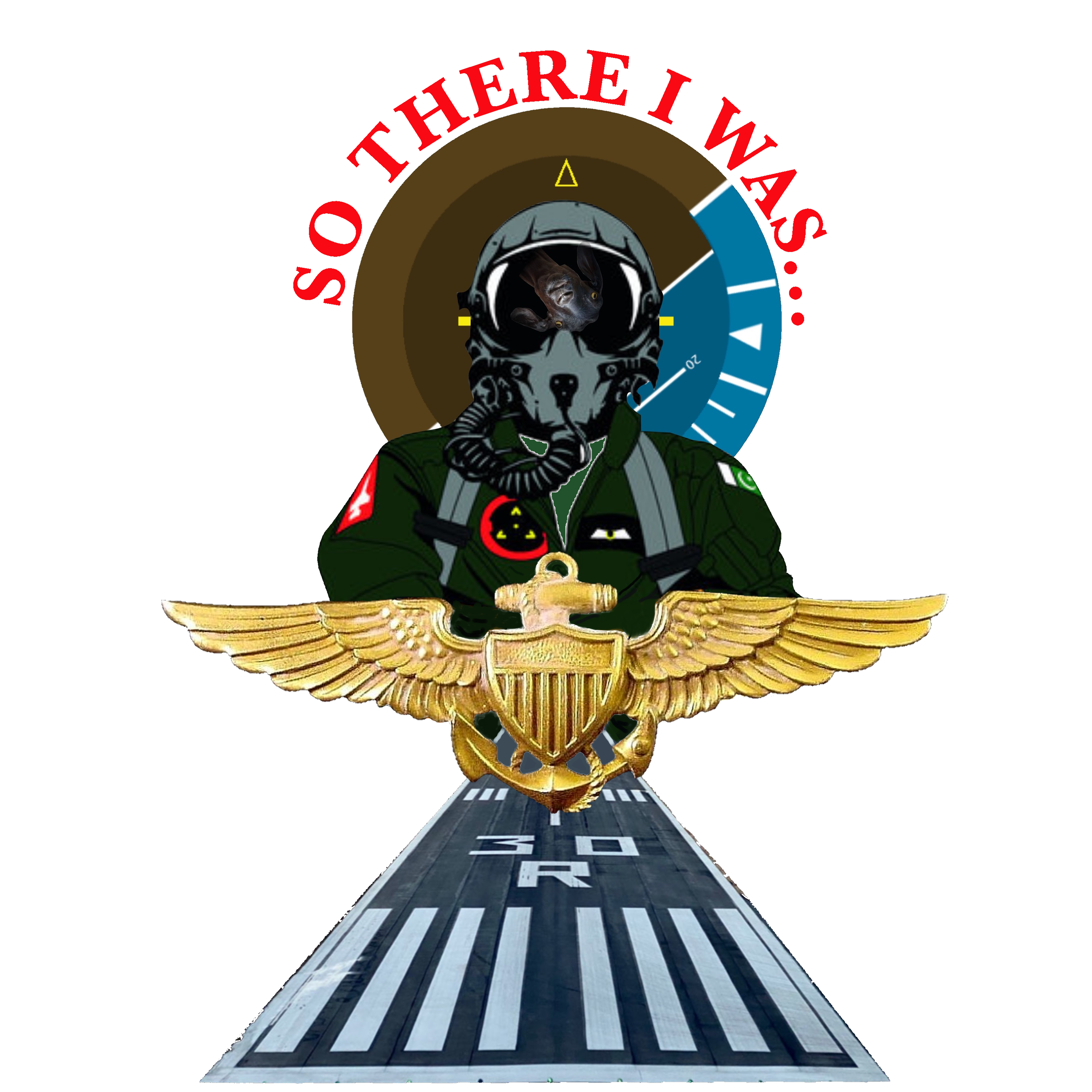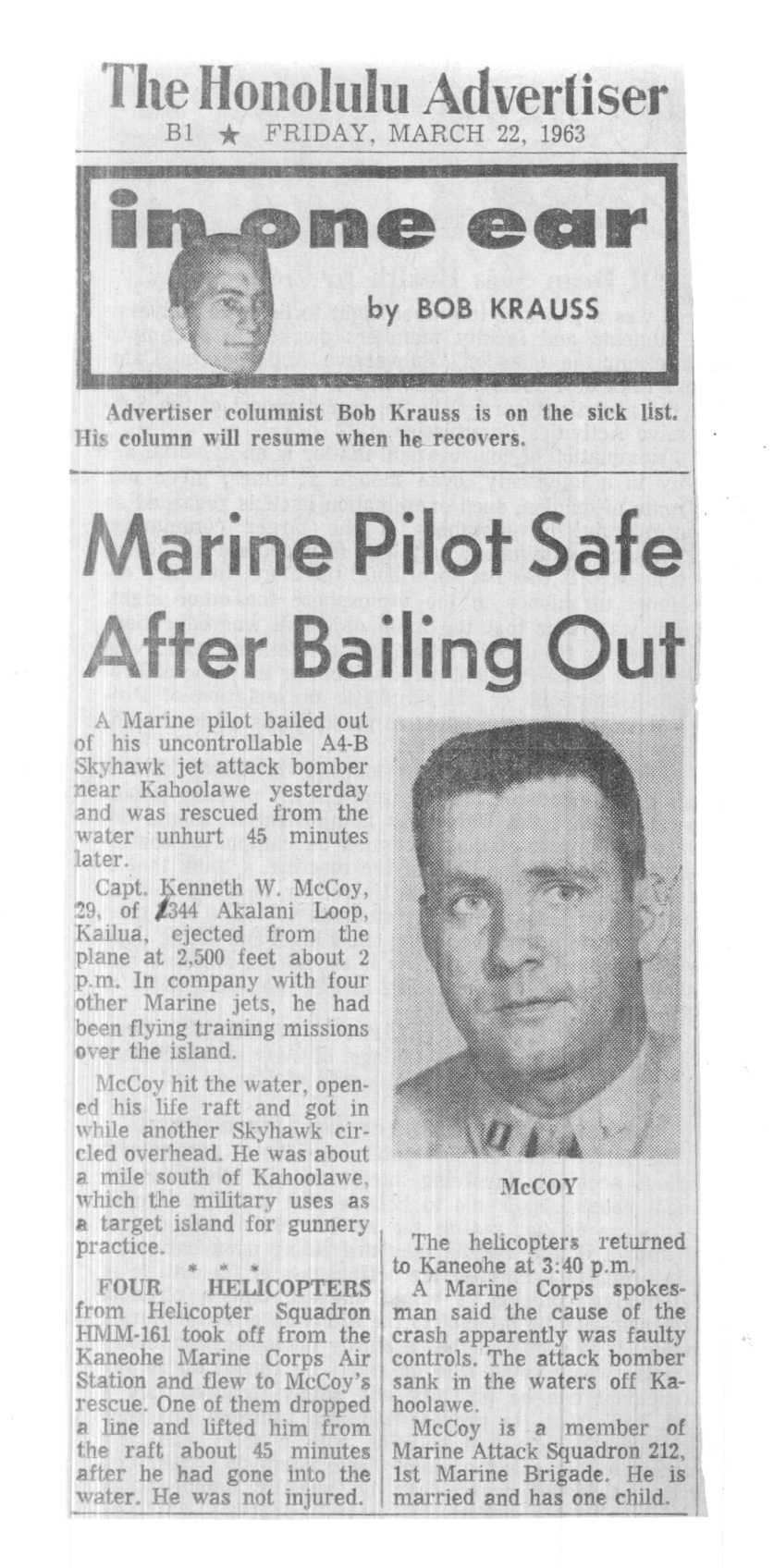
Listener Earl writes to tell us why he listens and honors his father, Marine Pilot Ken McCoy: I want to say that you guys have a great podcast going. Yours is by far my favorite podcast. I listen to many military aviation related podcasts and your is the most fun. My father was a Marine Aviator. He was a NavCad in 1954 and once he got his wings as an Ensign in the Navy they offered them to transfer to the Marine Reserves as a 2nd Lt. He went to the Basic School at some point after. He did primary in the SNJ at Whiting Field, Formation at Saufley Field, FCLP’s at Barin Field and carrier qual’d on the USS Siapan in the SNJ. He was in the first group that got to fly the new, at the time, T-28B Trojan during instrument training at Corry Field. He went on to fly T-33 jets in primary jet training and the F9-F Panther in advanced jet training at Sherman Field.
He flew everything from SNB’s which was the old twin tailed Beechcraft, C-47, C-54. He also trained for helicopters and flew the H-19 and H-34 helicopters. In the 60”s he got requalified in jets in the TF9-F Cougar and transferred from MCAS El Toro to MCAS Kaneohe Bay joining the VMA-212 Devil Cats flying the A-4B Skyhawk. You probably know them now 212 as the Lancers. When they transitioned to the F-8 Crusader they became VMFA-212 Lancers as the Lancer went better with the medieval them of the Crusader. My dad ejected from an A-4 in 1963 and due to a couple of other A-4 mishaps all related to maintenance, Dad requested to go back to helicopters and joined HMM-161 Greyhawks. He went to Vietnam in 1965 flying the H-34 with HMM-161 and at the time they were known as the Pineapple Squadron due to their Hawaii home.
Dad always regretted not flying an afterburning jet, but said he was never more proud of serving the grunts on the ground than with the helicopters.

This is one of the reasons I love your podcast, because the stories and hijinks of the Marines remind me of the stories he used to tell me. I love the podcast because you are getting these stories and history told. Dad passed away back in 2012 and I regret that I didn’t record some of his stories and wish he could have done a podcast like yours. He retired in Pensacola in 1968 due to back issues from the ejection. From late 1966 to 1968 he was a Land Survival Instructor at NAS Pensacola. You may remember the old PBY Catalina that they had in the Land Survival Building where half of the fuselage was outside of the building and the other half was inside the building with cutaways. It is now in the Navy museum. He used to talk about taking students out to Eglin AFB to stay in the woods for days eating grub worms for survival training.
Growing up in Pensacola, Dad always took me to the Blue Angel airshows back when they were flying the Skyhawks and tell me as a little boy that there was always a Marine pilot representing on the team. I am a huge fan of the Blue Angels. I loved the Lawman episodes and cracked up at the walk down hijinks. I also loved the trivia like HAM’N and Beer Can Width. Keep up the good work. I look forward to every Thursday. Semper Fi!



One thought on “Listener eMail 1”
To give a little more detail of his ejection: Dad was in a section of A-4’s doing a practice bombing run on an uninhabited island off the coast of Maui called Kahoolawe. They were tossing practice bombs where they would do a shallow dive at the target and then pull up releasing the bomb basically tossing the bomb a further distance so they could get away from the bomb blast. Dad had pulled up hard and released the bomb and while pulling off the target his control stick locked. He extended the stick which was an emergency procedure to mechanically override the hydraulic system and he was still unable to move the stick. During these attempts to regain control which was only a few seconds the aircraft had done the first half of a big barrel roll and he was now in an inverted nose down dive at the ocean at 2,500 ft. and over 550 kts. He decided it was time to depart the aircraft and called something like “Bobcat 2 ejecting!” The force of the ejection ripped out three sections of the parachute and he blacked out for a few seconds. He said when he came to, it was so violent he thought the parachute had caught on the vertical stab of the aircraft.
I have his torso harness that has rips from the chest area where the parachute was attached all the way up to the tops of the shoulders.
He remembered looking down and seeing foam in the ocean where the jet had impacted the water. He said his wingman told him the he counted “One Mississippi, Two Mississippi… all the way to Five, from the time he punched out till the plane hit the water.
He said that when they solo’d in the Skyhawk, since it was single seat, that their squadron mates would carry them across the tarmac and throw them into Kaneohe Bay and there were MP’s standing guard with M-16’s on the dock waiting to shoot sharks since the area was so shark infested. He remembered this when he had climbed into the raft and he could feel a shark under the raft nudging him while he was floating there waiting for rescue. It turns out it was just the cord that he had pulled to inflate the raft had folded underneath and was tapping the bottom of the raft.
He used to tell me that after the ejection his body looked like he had a hickey from the waist up and over the next few weeks he turned every shade of purple that existed. Earl McCoy
Comments are closed.